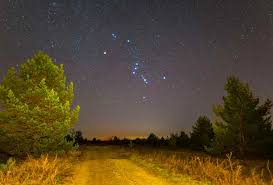Orion Stars: Unveiling the Mysteries of the Night Sky is a famous constellation that has attracted people for centuries. Stargazers have been captivated by its unusual silhouette and brilliant stars for generations. In this post, we will dig into the world of the Orion Stars and uncover some of the mysteries of the night sky.
Orion: what is it?
One of the most famous and easily recognizable constellations is Orion, the Hunter. It lies on the celestial equator; thus, skywatchers in the northern and southern hemispheres can see it equally well. Orion, the constellation named for the Greek mythological Hunter, has particular cultural and astrological importance.
The Constellation of Orion
Several prominent stars come together to form Orion’s pattern. The three stars that makeup “Orion’s Belt” are evenly spaced, giving the constellation the appearance of an hourglass. In addition, the shoulders of the Hunter are represented by the two bright stars Betelgeuse and Rigel.
Mythical Orion
Stories about the constellation Orion can be found all around mythology. Orion was a giant and an expert hunter in Greek mythology. Several myths center around him, including the constellations Taurus and Scorpius, the dreaded scorpion. The stories give the Orion constellation more dimension and awe.
Find Orion’s Position
Finding Orion in the sky is an enjoyable challenge. It can be seen in the northern hemisphere during the winter and the southern hemisphere during the summer. The stars will make an obvious hourglass, so watch for it.
Stars and Bright Objects in the Orion Nebula
Orion is not only interesting because of its general form; there are many fascinating stars and things within its boundaries. Some of the more prominent features of this constellation are as follows:
The Nebula in Orion
New stars form in the breathtaking Orion Nebula, Messier 42. Astronomers and astrophotographers often aim their cameras at this stellar nursery.
Belt of Orion
The three stars Alnitak, Alnilam, and Mintaka make up the distinctive Belt of Orion. When people see Orion in the sky, those are the first things they usually notice.
Most Luminous Stars Betelgeuse and Rigel
Red supergiant Betelgeuse and blue supergiant Rigel are Orion’s brightest stars. They are essential to astronomers and add to the attraction of the constellation.
This year’s Orionid Meteor Shower
The Orionid meteor shower, linked to Halley’s Comet, often occurs around October. As Earth moves through the comet’s leftover material, we are treated to a breathtaking display in the heavens.
Orion’s Role in Human History
Orion has been significant to many cultures throughout history. It was an essential tool for navigation and served as a seasonal indicator. Its significance is evidenced by the fact that it was included in the mythologies and calendars of ancient cultures.
Telescopes and Modern Observations
Improvements in astronomical equipment have made watching Orion more exciting. Advances in telescope and space-based observatory technology have allowed for more in-depth constellation study.
Astronomical research on Orion
Astronomers examine Orion to learn more about the processes that lead to new stars and the evolution of old ones. It’s a fantastic place to study stellar evolution and birth.
Interesting Orion Facts
The distance between Earth and the Orion Nebula is 1,350 light-years.
The three stars that makeup Orion’s Belt are not connected beyond their proximity in the sky at night. The Hebrew name for Orion, “Kesil,” reflects the significance of this constellation to ancient peoples.
Conclusion
The constellation Orion has long held the interest of scientists and mythologists alike for its symbolic and scientific relevance. Because of its unique arrangement and fascinating features, the Milky Way is a cosmic gem that helps us better understand the vastness of space.
Questions and Answers (FAQs)
Can I view Orion in both the northern and southern hemispheres?
Throughout the year, Orion may be seen from the northern and southern hemispheres.
When do we have the clearest skies to see Orion?
Those in the northern hemisphere should look for Orion in the winter, while those in the southern hemisphere should do so in the summer.
Is the constellation Orion connected to any well-known meteor showers?
The Orionid meteor shower, which happens in October, is connected to Halley’s Comet.
The distance of the Orion Nebula from Earth is four.
About 1,350 light-years from Earth is where you’ll find the Orion Nebula.
Is there any physical connection between the stars in Orion’s Belt?
The three stars that makeup Orion’s Belt are not connected beyond their proximity in the sky at night.




